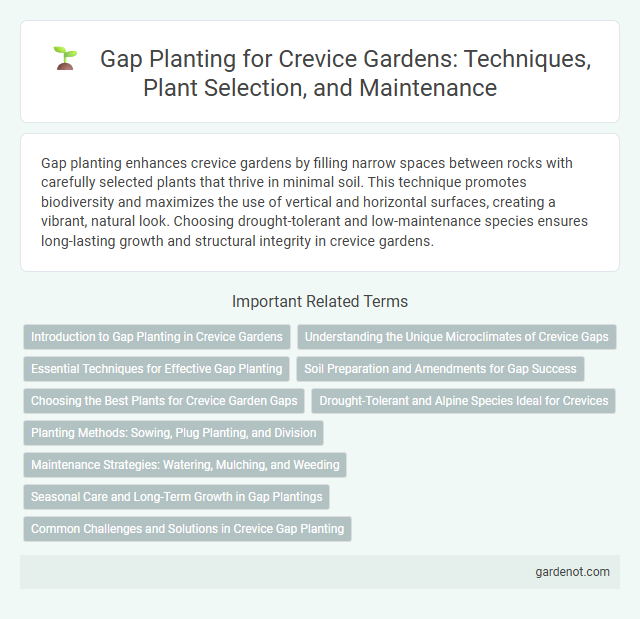Gap planting enhances crevice gardens by filling narrow spaces between rocks with carefully selected plants that thrive in minimal soil. This technique promotes biodiversity and maximizes the use of vertical and horizontal surfaces, creating a vibrant, natural look. Choosing drought-tolerant and low-maintenance species ensures long-lasting growth and structural integrity in crevice gardens.
Introduction to Gap Planting in Crevice Gardens
Gap planting in crevice gardens involves strategically placing plants in the narrow openings between rocks to maximize growth and aesthetic appeal. This technique leverages the unique microclimates and drainage conditions within the crevices, supporting drought-tolerant and alpine species such as sedums, saxifrage, and sempervivum. By selecting species suited to these gaps, gardeners enhance biodiversity and ensure resilient plantings that thrive in minimal soil environments.
Understanding the Unique Microclimates of Crevice Gaps
Gap planting in crevice gardens leverages the distinct microclimates created by narrow fissures between rocks, which offer varying levels of sunlight, moisture, and temperature. These microclimates provide ideal conditions for specialized alpine and drought-tolerant plants that thrive in well-drained, sheltered environments. Understanding these unique niches ensures successful growth and enhances biodiversity by accommodating species with specific ecological needs.
Essential Techniques for Effective Gap Planting
Gap planting enhances crevice gardens by carefully selecting plants that thrive in narrow spaces and rocky environments. Essential techniques include choosing drought-tolerant, low-maintenance species with deep root systems that stabilize soil and prevent erosion. Proper spacing and layering of plants create a naturalistic appearance while maximizing sunlight exposure and airflow for healthy growth.
Soil Preparation and Amendments for Gap Success
Effective soil preparation for gap planting in crevice gardens involves ensuring well-draining, nutrient-rich soil to support root development within narrow spaces. Incorporating organic amendments such as compost or well-rotted manure enhances soil structure, moisture retention, and fertility, promoting healthy plant growth. Testing soil pH and adjusting it to suit specific plant requirements further optimizes conditions for successful gap planting.
Choosing the Best Plants for Crevice Garden Gaps
Selecting plants for crevice garden gaps requires prioritizing drought-tolerant, low-maintenance species adapted to shallow, well-drained soil conditions. Succulents, alpine plants, and compact perennials such as sedum, thyme, and sempervivum thrive best due to their ability to withstand temperature fluctuations and limited nutrients. Ensuring plants have strong root systems that anchor well within narrow crevices optimizes growth and prevents erosion.
Drought-Tolerant and Alpine Species Ideal for Crevices
Gap planting in crevice gardens thrives with drought-tolerant and alpine species such as Sedum, Sempervivum, and Saxifraga, which excel in minimal soil and harsh conditions. These plants possess deep root systems that anchor into narrow rock fissures, ensuring water retention and resilience during dry periods. Their compact growth habit and adaptability to temperature fluctuations make them ideal for creating sustainable, low-maintenance crevice garden designs.
Planting Methods: Sowing, Plug Planting, and Division
Gap planting in crevice gardens enhances visual continuity by filling empty spaces with carefully selected species suited for narrow soil pockets. Effective planting methods include sowing seeds directly into crevices for natural growth patterns, plug planting for quicker establishment using young plants, and division of mature perennials to propagate resilient specimens while minimizing transplant shock. These techniques ensure sustained biodiversity and robust coverage in the unique microhabitats created by crevice formations.
Maintenance Strategies: Watering, Mulching, and Weeding
Effective maintenance of crevice gardens involves optimizing watering techniques to ensure deep soil moisture without over-saturation, which supports the health of drought-tolerant plant species. Applying mulch conserves soil moisture, suppresses weed growth, and stabilizes soil temperature, enhancing plant root development in narrow, rocky gaps. Consistent weeding prevents competition for nutrients and space, maintaining the integrity of gap planting arrangements and promoting vigorous plant growth.
Seasonal Care and Long-Term Growth in Gap Plantings
Gap planting in crevice gardens requires seasonal care to ensure plant health and vitality throughout the year. Regularly monitoring soil moisture and pruning during dormant seasons promotes long-term growth by encouraging root establishment and minimizing competition. Utilizing native or drought-tolerant plant species enhances resilience and sustained development in these narrow planting spaces.
Common Challenges and Solutions in Crevice Gap Planting
Common challenges in crevice garden gap planting include soil retention issues, insufficient drainage, and plant establishment difficulty due to narrow spaces. Solutions involve using high-quality, well-draining soil mixes tailored for crevice conditions and selecting drought-tolerant, shallow-rooted plants like Sedum and Saxifrage to ensure stability and moisture retention. Regular maintenance such as removing debris from gaps and monitoring water levels improves plant growth and gap integrity over time.
Gap planting Infographic

 gardenot.com
gardenot.com